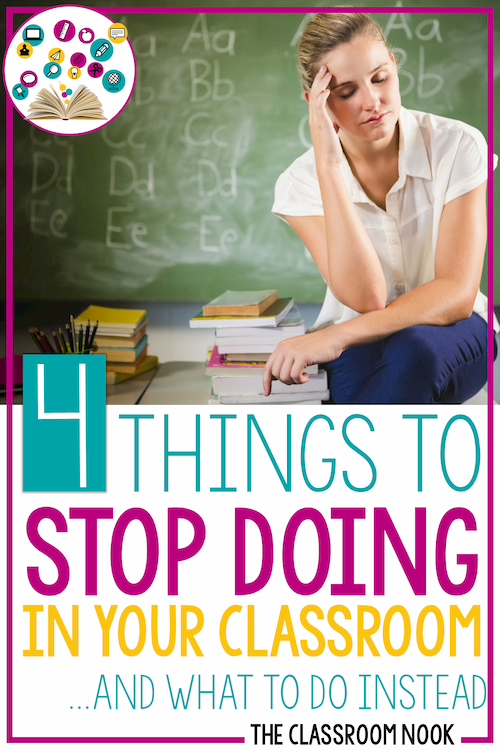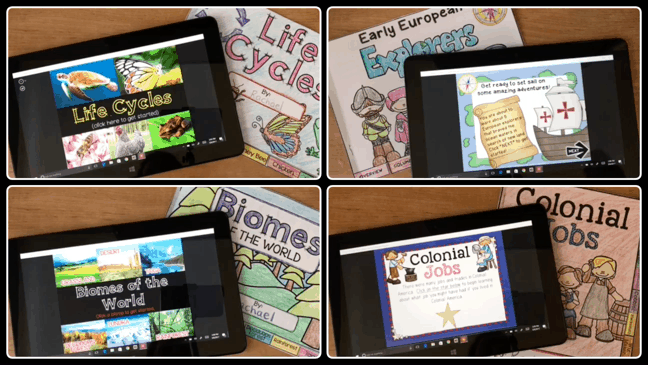4 Things to STOP Doing In Your Classroom (and what to do instead)
Love podcasts? Check out this post in the form of a podcast episode on The Classroom Commute Podcast:

We all have those things that we have done with our students those first couple years of teaching that make us now cringe.
I won't waste your time telling you all about my mistakes, but I would like to share with you a few things that you could change about your teaching practices today to make a bigger impact on your students.
Here are 4 things that you should STOP doing in your classroom ...and what you can do instead!
STOP: HAVING STUDENTS RAISE THEIR HANDS TO ANSWER
We all ask students to raise their hand to answer questions, right? It's a classic classroom management technique and it prevents chaotic conversation. But - here's why you might want to consider stopping this participation strategy:
When you call on a student to answer a question, you are only able to assess ONE students' understanding of the topic and hear ONE students' thinking behind their answer. Everyone else is off the hook in answering the question and allows them to become passive learners in your classroom instead of engaged learners.
INSTEAD...
Require 100% participation from all of your students by trying one of these alternatives.
Have students write the answer down on a dry erase board or inside a journal where you can glance at each students' response quickly before discussing it as a class. You'll easily see who understands and who doesn't.
Have students point to the answer. If you're looking at an article together, or inside a textbook, or anything activity sheet on their desk where the answer can be found, have all students point to where they find their answer. Again, a quick glance around the room will give you an over-all assessment of students understanding.
Have students "turn and talk." Have students share their thinking with the person sitting next to them. Eaves-drop in on their conversations to hear what each student has to say.
Use "SHOW WHAT YOU KNOW" cards. This is such an easy tool that you can have on hand to quickly assess a students' understanding of a topic. Students have their own set of cards with a variety of topics where they can cover up the answer with their thumb and then show you their answer.
Here's how it works:
I created several different cards for different topics where students can quickly show me the answer to a question that I ask related to that topic. I called these my "Show What You Know" cards. On the cards were generic answers to questions that I might ask about different topics to see what my students remembered or understood about what I taught them.
For example, for teaching about primary and secondary sources, I had a card with two answers on it: primary source and secondary source.
When checking my students' understanding of the difference between primary and secondary sources, I could show my students different examples each kind of source and then have them place their finger over the circle next to the correct answer and hold it up for me to see. It was easy for me to scan the room and see who's got it and who doesn't. Students would repeat this process for each question. I could ask follow up questions, as needed.
FREE sample set of assessment cards
Check your students' comprehension in just a few minutes with one simple assessment tool: show what you know cards!
Students place their finger over the correct answer on the card to indicate their understanding. Teachers can easy scan the room for a quick assessment! Cards provided with a variety of topics!
I've got a whole lot more to share with you about encouraging whole-class participation! Check out the video below with TONS of ideas! (or grab the cliff notes here)
STOP: ROUND ROBIN READING
I remember being in elementary school where my teacher would have us go around the room taking turns reading. All I can remember was trying to figure out where in the text we would be when it was my turn.
What did that mean? It meant I was paying NO attention to the information my classmates were reading, but instead practicing the portion of the text I would have to read.
Round robin reading can be paralyzing to students who struggle with reading and it only pushes them away from loving to read.
INSTEAD...
Here are some alternatives for round robin reading:
Partner Reading - Have students read with a partner so that each student can practice reading the text.
Echo Reading - Here, teachers read a portion of the text first to model pacing, fluency and expression. The students then mimic the teacher while following along with the text.
Read Silently - If working as a whole group or even in a small group, indicate a portion of the text that you'd like students to read (a few paragraphs at a time). While students are reading, you can listen to individual students read the portion to you before coming back together as a group.
Teacher Read Aloud - Sometimes, it's best for the teacher to read out loud to the group. This is the perfect time to model fluency, expression, and pacing. Students should have the text in front of them as well in order to follow along.
STOP: MAKING ALL THE DECISIONS IN YOUR CLASSROOM
If we want students to learn how to make good choices, we've got to give them the chance! As a classroom teacher myself, I was petrified of letting students take the reigns because I always assumed chaos would ensue (and let's be honest, sometimes it did!).
I would often control the topics that they'd write about, the books that they'd read, the students that they would work with, the projects we would do...the list goes on.
But - the reality is if we're always telling students what to do and how to do it, we are stifling their creativity and preventing them from becoming positive decision-makers.
INSTEAD...
We can empower students to be active participants in their learning by letting them make more decisions in our classrooms. Here are some simple ways to release more responsibility on your students:
Give students the choice of using technology (websites, learning apps...etc) vs. traditional resources (books, articles...etc.)
Allow students choice in showing how they've learned with the use of choice boards
Consider using flexible seating during your school day
Give students choices in their assessments by allowing provide multiple formats of showing their learning
Allow students to participate in reading partnerships where they choose a partner to explore a new book with.
You May Also Like to Read:
STOP: WASTING TOO MUCH PAPER
I realize that this last tip is not 100% possible for every classroom as not all teachers have access to the same amount of technology. However, if you're in a school where you have access to technology, I encourage you to take advantage of it as much as you can.
Developing technology skills such as researching online are 21st century skills that our students need to have. The use of learning software provides wonderful alternatives to traditional paper/pencil activities.
INSTEAD...
Many schools are becoming a 1:1 school making it so that each student has access to a personal digital device such as iPads, chrome books, tablets...etc. In these cases, consider the use of Google Classroom apps to cut down on the amount of copies that you are making for your students.
Check out these video tutorials all about using Google Classroom and other technology resources in your classroom:
I've been hard at work creating several google classroom resources for teachers who have access to such technology. From novel units to science and social studies units and more...I love providing Google Classroom compatible resources for teachers!
Of course Google Classroom isn't the only digital option! For the last couple of years, thousands of teachers have begun using LINKtivity digital learning guides in their classrooms to teach multiple concepts.
You May Also Like to Read: ENGAGING YOUR LEARNERS WITH LINKtivity DIGITAL LEARNING GUIDES
Tap into Our LINKtivity Library
Did you know that you can get an ALL-ACCESS pass to my entire vault of LINKtivity® Interactive Learning Guides?
You can! Inside the LINKtivity® Learning Membership!









